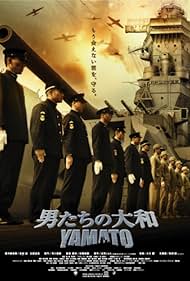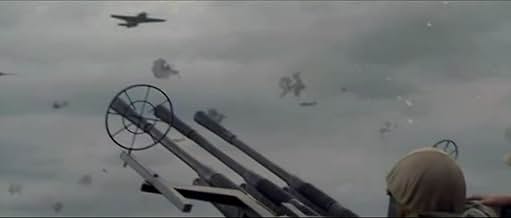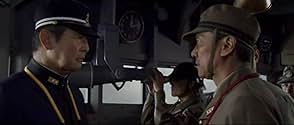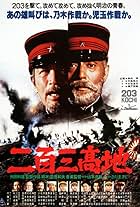IMDb RATING
6.4/10
2.5K
YOUR RATING
The movie follows 3 Japanese friends from embarking on Yamato, the world's largest battleship, until it's sunk 3 1/2 years later on April 7, 1945 on it's way to Okinawa to stop American adva... Read allThe movie follows 3 Japanese friends from embarking on Yamato, the world's largest battleship, until it's sunk 3 1/2 years later on April 7, 1945 on it's way to Okinawa to stop American advance at the end of WWII.The movie follows 3 Japanese friends from embarking on Yamato, the world's largest battleship, until it's sunk 3 1/2 years later on April 7, 1945 on it's way to Okinawa to stop American advance at the end of WWII.
- Awards
- 6 wins & 7 nominations total
Sôsuke Ikematsu
- Atsushi
- (as Sosuke Ikematsu)
Featured reviews
I am so disappointed to see some posters turning their reviews into cold historical commentary. Did this film not teach you anything? I couldn't help but be immensely moved by this film. It steers well clear of overly political and historical commentary and focuses on the young sailors and their loved ones. The hardship of the Japanese in the second world war was not unlike any other nations' peoples' hardship. Their loved ones went to war and never returned; they lost their livelihoods and what they loved; they were powerless to the whims of their leaders.
This film shows People. People in tragic times. People fighting for their loves and their lives. Whether it is Yamato, Saving Private Ryan, The Thin Red Line, Brotherhood, Stone's trilogy, Eastwood's duo of films, etc, it comes down to people trying to live. So much has been said about the film that is political but I ask you, what is the point of doing so for a film that strove so hard to in favour of a human story? After years of revisionist Hollywood war films, it is ironic that this moving film, Yamato, be raked over coals for inaccuracies or romanticism.
Besides this, however, and a technical note, the film's visual effects are excellent for a non-Hollywood film. I wouldn't be surprised if Yamato was one of the most expensive Japanese films ever made. While making an ocean going battleship replica was not an option, the sets, miniatures and CGI create a very gritty and realistic feeling of being aboard the fated ship.
Musically the film is also very striking and has some memorable themes throughout. The sound track is also superb with excellent separation in the 5.1 channels. The battle scenes are especially vivid in their aural presentation.
The amount of heart, work and effort that went into the film is clear from the exceptional cast, sound and competent visuals and their passionate and honest performances and work. This is definitely a film for the world to see. It is not a war film about "war"; it is a film about love. The message rings loud and clear until the final note of the closing credit's song.
This film shows People. People in tragic times. People fighting for their loves and their lives. Whether it is Yamato, Saving Private Ryan, The Thin Red Line, Brotherhood, Stone's trilogy, Eastwood's duo of films, etc, it comes down to people trying to live. So much has been said about the film that is political but I ask you, what is the point of doing so for a film that strove so hard to in favour of a human story? After years of revisionist Hollywood war films, it is ironic that this moving film, Yamato, be raked over coals for inaccuracies or romanticism.
Besides this, however, and a technical note, the film's visual effects are excellent for a non-Hollywood film. I wouldn't be surprised if Yamato was one of the most expensive Japanese films ever made. While making an ocean going battleship replica was not an option, the sets, miniatures and CGI create a very gritty and realistic feeling of being aboard the fated ship.
Musically the film is also very striking and has some memorable themes throughout. The sound track is also superb with excellent separation in the 5.1 channels. The battle scenes are especially vivid in their aural presentation.
The amount of heart, work and effort that went into the film is clear from the exceptional cast, sound and competent visuals and their passionate and honest performances and work. This is definitely a film for the world to see. It is not a war film about "war"; it is a film about love. The message rings loud and clear until the final note of the closing credit's song.
This is not the first time that I saw the sunk of Yamoto in Nippon movie. The precedent movie are "Rengo kantai" (1981), or additionally, some movie relative with Nippon naviation or 'Zero' fighter. With its poor battle result, the Yamoto was not more than a symbol of power, which main function was to satisfy people's adoration need, similar with the enthusiasm to sumotori of Japanese.
Though it praised the braveness of soldiers, it can't bear comparison with "Sink the Bismarck" (1960), in which the defeated Germany wined British's respect (It's ridiculous when a US veteran present his awedness to rival in the start and final of "Lorelei: The Witch of the Pacific Ocean" (2005)).
But this is not a historically narrative film. It also abandon the scanty criticism tradition of Japanese war movie before 90's. The tradition of vagueness of moral sense in Japanese movie is still there. No context was given to transmit the information about the cause to this tragedy, without which the sense of sacrifice to protect others is so pale. The script seemed to cater to the current civil circumstance. So this is a real "anniversary" movie within a predefined frame.
The cast were very good. Despite the unnaturalness of the plot corresponding to modern society, Tatsuya Nakadai is still my favorite actor. It's a pity that Japanese movie is losing its classic art orientation and international influence after the fade of masters directors.
The 3D effect is just so so, light is somewhat dim, and the color is always monotonously the hull's hue. Fortunately, the wave is no longer that appeared in old movie adopt the ship model. Music is better than "Lorelei: The Witch of the Pacific Ocean".
Though it praised the braveness of soldiers, it can't bear comparison with "Sink the Bismarck" (1960), in which the defeated Germany wined British's respect (It's ridiculous when a US veteran present his awedness to rival in the start and final of "Lorelei: The Witch of the Pacific Ocean" (2005)).
But this is not a historically narrative film. It also abandon the scanty criticism tradition of Japanese war movie before 90's. The tradition of vagueness of moral sense in Japanese movie is still there. No context was given to transmit the information about the cause to this tragedy, without which the sense of sacrifice to protect others is so pale. The script seemed to cater to the current civil circumstance. So this is a real "anniversary" movie within a predefined frame.
The cast were very good. Despite the unnaturalness of the plot corresponding to modern society, Tatsuya Nakadai is still my favorite actor. It's a pity that Japanese movie is losing its classic art orientation and international influence after the fade of masters directors.
The 3D effect is just so so, light is somewhat dim, and the color is always monotonously the hull's hue. Fortunately, the wave is no longer that appeared in old movie adopt the ship model. Music is better than "Lorelei: The Witch of the Pacific Ocean".
The movie has a very touching human side, an a sinister historic side.
The human story inside the story also is moving.
The major flaw of it, is that is too long. It gets unnecessary and frequently lost in details.
The human story inside the story also is moving.
The major flaw of it, is that is too long. It gets unnecessary and frequently lost in details.
Huge scale tale of the battleship Yamato and its crew. from 1942 to its sinking. Told in flashback as memories are provoked in a survivor by a woman, the daughter of another survivor, wanting to visit the final resting place on the 60th anniversary of its sinking. This is a story of youthful idealism tinged and changed by the course of war and a culture that celebrates death in battle as something glorious. It examines why men fight and what can we hope to get out of war.
This is a very good and moving film. For all of the clichés (is there a well worn plot device it doesn't have?) it does manage to touch the heart and the head. We really do care about the characters we see up on the screen, and what happens to them, death in a foolish adventure, moves us. At the same time we get to see the waste that is war and was the Japanese war effort in the final days of World War Two. Its made clear that the fight to the end mentality leaves no room for tomorrow. Its best expressed in a simple scene on the bridge of the ship. One of the officers is asked to explain the difference between chivalry, the Western code of war, and Bushido, the Japanese code. Bushido, he says is preparing for a death with no reward, Chivalry is trying to live a noble life. Its a difference that all of the men can see but which very few ever get the chance to live by. Even the survivors, the old man essentially telling the story, is haunted by the fact that he lived and everyone else died.As the film asks plainly, if we all die, who's going to be around to take advantage of our sacrifices? Its a question that needs to be asked in this age of suicide bombers. There is a great many other thematic threads running through this film that lift it out of the typical war movie pile.
The cast is top notch. They manage to take what is often a clichéd script and to infuse it with the power of reality. Modern sequences aside, you care for these people and you are moved by what happens to them. The tears that well up in the final modern scenes come from the fact that the cast of the war sections is so good that you carry over the emotion. I wish that the modern sequences had given the actors something to do other than simply push the story into action.
Technically the film is very impressive. The Yamato, is monster of a ship and its plain to see that great care was taken in recreating it. Its a beautiful movie to look at with the entire film having a wonderful sense of place and time. The two battle scenes are graphic in a way that I've never seen in a naval war film (if you don't like blood you may want to look elsewhere.) This is going to be something to rattle the windows with on DVD.
If the film has any real flaw thats its length. The film is about two and a half hours long and to be honest it probably could have been shorter. I was getting fidgety during some of it. Its not that its bad, its just that the films pace allows you too much time to dwell on some of the by the numbers construction of the plot so you just want the film to get to the next bit (what another tearful goodbye?). It doesn't kill the film, it just makes it hard to truly get lost in the story.
If you like war films, or good movies this is one to keep an eye out for. Just be ready to do a little digging since I'm not sure if this is going to get a regular release outside of Asia.
This is a very good and moving film. For all of the clichés (is there a well worn plot device it doesn't have?) it does manage to touch the heart and the head. We really do care about the characters we see up on the screen, and what happens to them, death in a foolish adventure, moves us. At the same time we get to see the waste that is war and was the Japanese war effort in the final days of World War Two. Its made clear that the fight to the end mentality leaves no room for tomorrow. Its best expressed in a simple scene on the bridge of the ship. One of the officers is asked to explain the difference between chivalry, the Western code of war, and Bushido, the Japanese code. Bushido, he says is preparing for a death with no reward, Chivalry is trying to live a noble life. Its a difference that all of the men can see but which very few ever get the chance to live by. Even the survivors, the old man essentially telling the story, is haunted by the fact that he lived and everyone else died.As the film asks plainly, if we all die, who's going to be around to take advantage of our sacrifices? Its a question that needs to be asked in this age of suicide bombers. There is a great many other thematic threads running through this film that lift it out of the typical war movie pile.
The cast is top notch. They manage to take what is often a clichéd script and to infuse it with the power of reality. Modern sequences aside, you care for these people and you are moved by what happens to them. The tears that well up in the final modern scenes come from the fact that the cast of the war sections is so good that you carry over the emotion. I wish that the modern sequences had given the actors something to do other than simply push the story into action.
Technically the film is very impressive. The Yamato, is monster of a ship and its plain to see that great care was taken in recreating it. Its a beautiful movie to look at with the entire film having a wonderful sense of place and time. The two battle scenes are graphic in a way that I've never seen in a naval war film (if you don't like blood you may want to look elsewhere.) This is going to be something to rattle the windows with on DVD.
If the film has any real flaw thats its length. The film is about two and a half hours long and to be honest it probably could have been shorter. I was getting fidgety during some of it. Its not that its bad, its just that the films pace allows you too much time to dwell on some of the by the numbers construction of the plot so you just want the film to get to the next bit (what another tearful goodbye?). It doesn't kill the film, it just makes it hard to truly get lost in the story.
If you like war films, or good movies this is one to keep an eye out for. Just be ready to do a little digging since I'm not sure if this is going to get a regular release outside of Asia.
The destruction of the giant battleship by overwhelming Allied air power following the destruction from the air of 3 previous giant Axis battleships (Bismarck, Musashi and Tirpitz) was a gigantic tragedy of common enlisted soldiers defending their "fatherland".
The mission accomplished nothing but another one-sided slaughter of "obedient soldiers". This is the real tragedy of men educated for obedience. Germans and Japanese alike.
And they were killed with millions against overwhelming (and technically also superior) powers by an opportunistic and docile dictatorship, leaving behind millions of sorrowing wives and children which never saw much of their fathers.
Otoko-tachi no Yamato shows us the common Japanese soldiers as human beings. No propaganda at all, unlike so many US war movies.
Its counterpart was the German movie "Das Boot". The difference is that in Germany the process of showing World War II as it was started earlier than in Japan. Even the horrendous loss of the Wilhelm Gustloff (10.000 dead)has been shown in a movie on the German television recently. In Japan the horrors of WWII finally are being shown to the public. While Germany feels "very guilty" for many decades, this process in Japan not really has been started yet.
The mission accomplished nothing but another one-sided slaughter of "obedient soldiers". This is the real tragedy of men educated for obedience. Germans and Japanese alike.
And they were killed with millions against overwhelming (and technically also superior) powers by an opportunistic and docile dictatorship, leaving behind millions of sorrowing wives and children which never saw much of their fathers.
Otoko-tachi no Yamato shows us the common Japanese soldiers as human beings. No propaganda at all, unlike so many US war movies.
Its counterpart was the German movie "Das Boot". The difference is that in Germany the process of showing World War II as it was started earlier than in Japan. Even the horrendous loss of the Wilhelm Gustloff (10.000 dead)has been shown in a movie on the German television recently. In Japan the horrors of WWII finally are being shown to the public. While Germany feels "very guilty" for many decades, this process in Japan not really has been started yet.
Storyline
Did you know
- TriviaPart of the foredeck and port side of the Yamato were reconstructed to full scale for the exterior scenes. As the Japan Building Standards Act interfered with re-creating the ship's entire superstructure, images of a one-tenth scale model of the Yamato at its namesake museum in Kure were used in post-production.
- GoofsThe ship is seen firing salvos from its main batteries aimed at approaching US aircraft on several occasions, while lots of the crew are visible on deck, manning the light AA guns as well as performing other duties. While the big guns were in fact used fending off aircraft, at least during the last battle off Okinawa, the shock wave from the blast of the nine 460 mm barrels (the biggest ever on a warship) could kill or severely injure an unprotected sailor, it was therefore forbidden to remain on deck on such occasions.
- Quotes
Mamoru Uchida: [Firing an AA gun defiantly as the ship sinks] I'm not done yet! My last throw!
- How long is Yamato?Powered by Alexa
Details
- Release date
- Country of origin
- Official site
- Language
- Also known as
- The Pacific Battleship: Yamato
- Filming locations
- Production companies
- See more company credits at IMDbPro
Box office
- Gross worldwide
- $39,287,114
- Runtime2 hours 25 minutes
- Color
- Sound mix
- Aspect ratio
- 2.35 : 1
Contribute to this page
Suggest an edit or add missing content
























